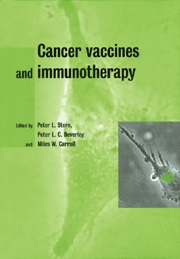Book contents
- Frontmatter
- Contents
- List of contributors
- 1 Immunity and cancer
- 2 Immunotherapy of bladder cancer
- 3 Poxviruses as vectors for cancer immunotherapy
- 4 Vaccinia-based human papillomavirus vaccines in cervical cancer
- 5 Vaccine delivery and immunosuppression in cervical cancer
- 6 Vaccines for colon cancer
- 7 MUC1 vaccines and breast cancer
- 8 Anti-idiotypic vaccination
- 9 Immunotherapy and vaccination against Epstein–Barr virus-associated cancer
- 10 Serologically identified tumour antigens as cancer vaccines
- 11 CTL-defined cancer vaccines in melanoma and other epithelial cancers
- 12 DNA vaccines against B-cell tumours
- 13 Dendritic cell approaches to immunotherapy
- 14 Overview
- 15 Recent developments
- Index
10 - Serologically identified tumour antigens as cancer vaccines
Published online by Cambridge University Press: 06 January 2010
- Frontmatter
- Contents
- List of contributors
- 1 Immunity and cancer
- 2 Immunotherapy of bladder cancer
- 3 Poxviruses as vectors for cancer immunotherapy
- 4 Vaccinia-based human papillomavirus vaccines in cervical cancer
- 5 Vaccine delivery and immunosuppression in cervical cancer
- 6 Vaccines for colon cancer
- 7 MUC1 vaccines and breast cancer
- 8 Anti-idiotypic vaccination
- 9 Immunotherapy and vaccination against Epstein–Barr virus-associated cancer
- 10 Serologically identified tumour antigens as cancer vaccines
- 11 CTL-defined cancer vaccines in melanoma and other epithelial cancers
- 12 DNA vaccines against B-cell tumours
- 13 Dendritic cell approaches to immunotherapy
- 14 Overview
- 15 Recent developments
- Index
Summary
Introduction
Vaccination strategies for the treatment of human cancer depend on the existence of tumour antigens which are able to elicit specific immune responses in the tumour-bearing host. The specific recognition of antigens by the immune system is accomplished by two targeting systems: CD4+ and CD8+ T lymphocytes recognize processed antigens presented on MHC class II and class I molecules, respectively, while B lymphocytes produce antibody molecules that bind specifically to unprocessed antigens. The analysis of humoral and cellular immune responses in cancer patients had indicated for a long time that cancer-specific antigens do indeed exist and are recognized by the immune system of the tumour-bearing host. However, the molecular nature of these antigens remained unclear until cloning techniques were developed that used established cytotoxic T lymphocyte (CTL) clones or circulating antibodies as probes for screening of tumour-derived expression libraries. The CTL approach and the antigens identified by it are reviewed elsewhere in this book (Chapter 11). This chapter is intended to give an introduction to the serological approach, to summarize the current status of antigens identified and to provide a perspective for the use of these antigens for cancer immunotherapy.
Rationale for using the antibody repertoire of cancer patients for the identification of tumour antigens
A variety of in vitro studies and animal tumour models demonstrated that CTLs are the protagonists of an effective cytotoxic antitumoural immune response and motivated the search for antigens recognized by CD8+ T lymphocytes.
- Type
- Chapter
- Information
- Cancer Vaccines and Immunotherapy , pp. 195 - 206Publisher: Cambridge University PressPrint publication year: 2000



